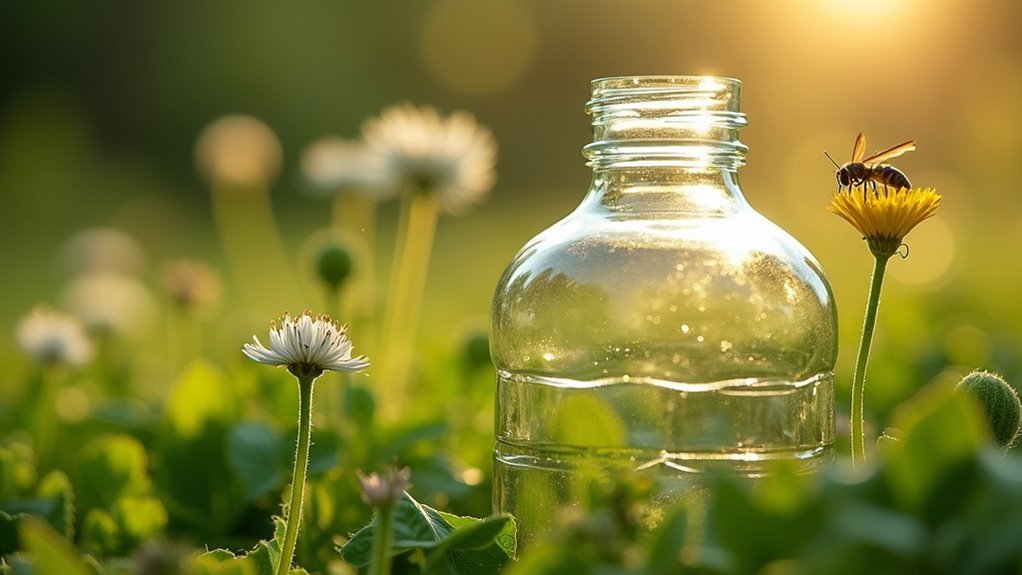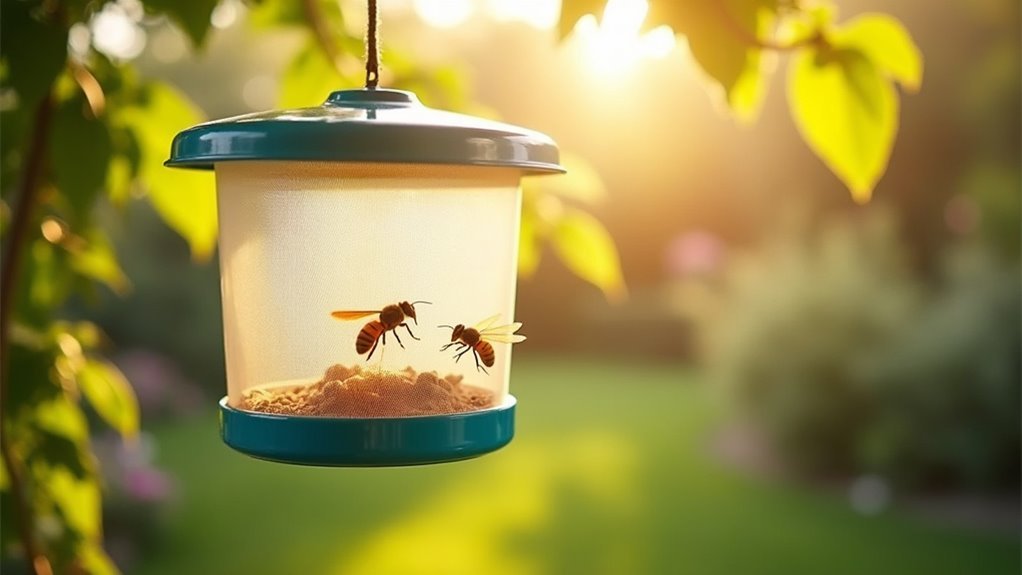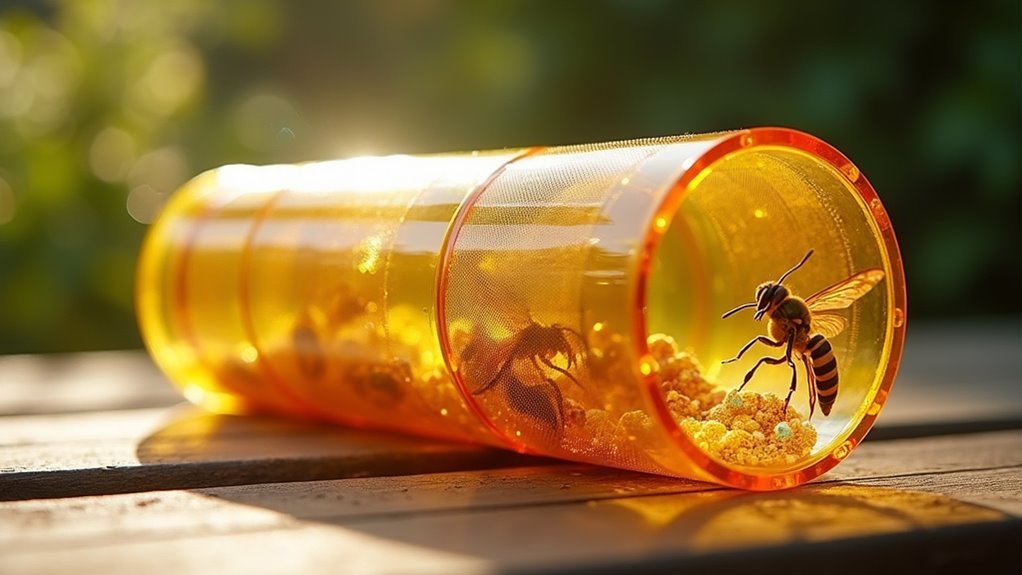You can create effective humane wasp traps using inverted plastic bottles with jam-water-soap bait that allows easy entry but difficult escape. Position traps 20 feet from gathering areas, 3-5 feet high, with proper ventilation through mesh sides. Monitor from safe distances without disturbing captured wasps, then release them 3+ miles away during early morning or evening hours. Regular cleaning and fresh bait maintain effectiveness while ensuring ethical treatment. These techniques offer thorough solutions for respectful wasp management.
DIY Bottle Trap Design for Safe Wasp Capture

Creating an effective wasp trap doesn’t require expensive equipment—just a simple plastic bottle and a few household items.
You’ll start by cutting off the top third of a recycled plastic bottle, then inverting it into the bottom section like a funnel. Secure this DIY bottle trap structure with tape around the edges.
For bait, mix jam with water and add a drop of soap, though fruit juice works equally well for attracting wasps. This mixture draws wasps within minutes of placement.
The inverted design allows wasps to enter easily but makes escape difficult.
The funnel-shaped entrance creates a one-way passage that traps wasps inside once they follow the scent of sweet bait.
Your lightweight, compact trap works perfectly in gardens, decks, or campsites, providing a reusable solution to your wasp problem without costly store-bought alternatives.
Natural Bait Solutions That Attract Without Harm
While your trap design provides the foundation for humane wasp capture, the bait you choose determines both effectiveness and safety.
Natural bait solutions like jam mixed with water and a drop of soap prove most effective in DIY trap tests. You’ll also find success with fruit juices and small protein pieces that attract wasps without toxicity concerns.
Regular bait changes and trap cleaning maintain effectiveness while preventing spoilage that could harm wasps.
These eco-friendly materials support sustainable pest control practices. The simple setup enables humane capture methods, giving you the flexibility to relocate wasps away from your living spaces rather than killing them.
This approach balances your need for wasp-free areas with environmental responsibility.
Proper Ventilation Techniques for Live Wasp Containment

Once you’ve captured wasps in your humane trap, maintaining proper airflow becomes essential for their survival and stress reduction. Your trap design should prioritize ventilation through mesh or perforated sides that create a breathable environment while preventing escape.
This thoughtful approach guarantees live wasp containment remains ethical and effective.
Key ventilation techniques include:
- Choose mesh-sided traps that allow continuous air circulation without compromising security
- Avoid overfilling with bait to maintain airflow and prevent wasps from drowning in excess liquid
- Add secondary lures like fake flowers to enhance scent distribution while improving ventilation
- Clean traps regularly to prevent waste buildup that blocks air passages and creates unhealthy conditions
Proper ventilation transforms your trap from a prison into temporary, humane housing that respects these important pollinators.
Strategic Trap Placement for Maximum Effectiveness
Strategic placement determines whether your carefully ventilated humane traps succeed or fail in capturing wasps effectively.
Proper trap positioning makes the difference between successful wasp capture and complete failure of your humane removal efforts.
You’ll want to position your traps in shaded areas where wasps seek cooler environments during hot weather. Place them at least 20 feet away from gathering spots to avoid drawing wasps toward people.
Hang multiple traps throughout your yard, especially near flowering plants and fruit trees where wasps commonly feed. Elevate each trap 3-5 feet off the ground for ideal visibility. This height makes traps more noticeable to flying wasps.
Monitor trap placement regularly and relocate based on wasp activity patterns. Their behavior changes seasonally as food sources shift, so you’ll need to adjust your strategy accordingly for maximum effectiveness.
Creating Multiple Entry Points With Single Exit Design

Although escape routes might seem counterintuitive, designing your humane trap with multiple entry points but only one difficult exit creates the most effective capture system.
You’ll cut your recycled plastic bottle’s top off and invert it into the bottom section, forming the primary funnel entrance. For larger bottles, add a second fake flower opening to enhance airflow and scent distribution from your baiting techniques.
This trap design offers several emotional benefits:
- Peace of mind knowing you’re using sustainable, reusable materials
- Satisfaction from creating an effective solution with simple household items
- Relief that wasps can’t easily escape once inside
- Confidence in your eco-friendly pest management approach
Your multiple entry points work together with jam-and-water bait, creating an irresistible attraction while maintaining the single, difficult exit route.
Non-Toxic Attractant Recipes Using Household Items
The right bait transforms your homemade trap from a simple container into an irresistible wasp magnet.
You’ll find that mixing jam with water creates a highly effective non-toxic attractant. Add a drop of soap to break the surface tension, helping trapped wasps drown quickly.
Apple juice works well as homemade bait, though it spoils faster than jam mixtures and requires frequent replacement.
For yellow jackets and hornets, try small pieces of protein-rich foods like hot dog or hamburger.
Sugar water with soap shows minimal success compared to other options.
Since effectiveness varies considerably between solutions, you should experiment with different combinations. Test multiple baits simultaneously to discover what works best in your specific environment and wasp population.
Safe Release Methods and Distance Recommendations
Once you’ve successfully captured wasps in your humane wasp trap, proper release becomes your next priority.
Safe release methods require careful planning to protect both you and the wasps. The release distance should be at least 3 miles from your home to prevent their return.
Effective wasp relocation demands strategic distance planning – release captured wasps at least three miles away to ensure they cannot navigate back home.
Follow these essential steps for a compassionate release:
- Choose a peaceful natural location like a garden or park where wasps can thrive without threatening families.
- Release during early morning or late evening when wasps are calmer and less likely to become aggressive.
- Gently tilt the trap to let them fly out naturally – never shake or force them out.
- Wear protective clothing and use a stick to maintain safe distance during the process.
This approach guarantees both successful relocation and your safety.
Seasonal Timing for Optimal Catch-and-Release Results
When you time your humane wasp trapping efforts with seasonal patterns, you’ll achieve considerably better catch-and-release results. Strategic seasonal timing involves understanding wasp behavior throughout the year.
Set traps in late spring to early summer to catch queen wasps before colonies expand. During peak activity in late summer and early fall, when food sources dwindle, wasps become most active and trappable.
| Season | Trap Focus | Monitoring Frequency | Success Rate |
|---|---|---|---|
| Late Spring | Queen wasps | Weekly | High |
| Early Summer | Colony prevention | Bi-weekly | Medium |
| Late Summer | Peak populations | Every 2-3 days | Highest |
| Early Fall | Aggressive foragers | Daily | High |
Optimal placement near gardens and dining areas, combined with effective bait solutions like jam-water-soap mixtures, maximizes your trapping success during these critical periods.
Maintenance and Cleaning Between Capture Cycles
Effective catch-and-release programs require consistent trap maintenance to sustain their success throughout these seasonal cycles.
You’ll need to regularly empty and clean your traps every few days to prevent spoiled bait from deteriorating effectiveness. This routine maintenance and cleaning guarantees peak performance while supporting ethical wasp management.
Your cleaning protocol should include:
- Thorough washing with warm, soapy water to remove residual attractants and dead wasps
- Careful inspection for plastic degradation or damage that compromises trap integrity
- Fresh bait preparation using jam, water, and soap drops for maximum attraction
- Proper storage in cool, dry locations during off-seasons
Users consistently provide feedback that well-maintained traps markedly outperform neglected ones.
Replace damaged components immediately to maintain humane capture standards and extend your equipment’s lifespan for future seasons.
Monitoring Trap Success Without Disturbing Captured Wasps
You’ll want to monitor your trap’s effectiveness without opening it and disturbing the captured wasps inside.
Position yourself at least 10-15 feet away and use visual inspection techniques to observe wasp activity around the entrance.
Clear plastic bottles work best since they’ll let you count trapped wasps and assess bait levels from a safe distance.
Visual Inspection Techniques
While successful wasp trapping depends on effective bait and placement, monitoring your trap’s performance requires careful observation techniques that won’t disturb the captured insects.
Visual inspections from a safe distance let you assess trap effectiveness without startling wasps or triggering defensive behaviors.
Effective monitoring strategies include:
- Taking photos with your smartphone from multiple angles to count captured wasps without opening the trap
- Observing flight patterns around your trap during different times to identify peak activity periods
- Recording non-target species attracted to refine your bait choices and placement decisions
- Moving quietly and calmly during inspections to prevent agitating the wasps inside
These gentle observation methods help you optimize your humane trapping approach while respecting the insects you’ve captured.
Safe Distance Observation
How can you accurately assess your trap’s performance without stressing the wasps you’ve captured? Safe distance observation is essential for maintaining natural wasp behavior while monitoring your trap’s effectiveness.
You’ll want to position yourself at least 10 feet away from your SKAbod Wasp Trap to avoid threatening the insects and guarantee ideal catch rates.
Use clear or colored bottles to easily visualize trapped wasps without getting too close. Monitor the trap at different times throughout the day, particularly during late afternoon when wasp activity peaks. This timing strategy helps you understand behavioral patterns and peak capture periods.
Regular distant checks allow you to assess when cleaning or bait replacement is needed while maintaining the trap’s effectiveness and keeping wasps calm.
Frequently Asked Questions
What Is the Best Liquid to Put in a Wasp Trap?
You’ll get the best results using a mixture of jam and water with a drop of soap. The soap breaks surface tension, helping trap wasps effectively, while the jam’s sweetness attracts them quickly.
What Is the Most Effective Homemade Wasp Trap?
You’ll get the best results using a recycled plastic bottle filled with jam and water plus a soap drop. Clean and refill regularly, and consider using larger bottles with enhanced airflow for maximum effectiveness.
What Do Professionals Use to Get Rid of Wasps?
Professionals use specialized traps with precise attractants, chemical sprays like pyrethroids for direct nest elimination, and physical exclusion techniques. You’ll find some services offer environmentally friendly options including nest relocation for humane removal.
What Is the Bait Recipe for a Wasp Trap?
You’ll want to mix jam with water and add a drop of soap to break surface tension. Stir thoroughly until jam dissolves completely, then fill your trap without overfilling it.
In Summary
You’ve now got ten effective methods to catch wasps humanely without causing them harm. Remember to check your traps regularly, maintain proper ventilation, and release captured wasps at least 500 yards from your home. Don’t forget to clean your equipment between uses and adjust your baiting strategy based on seasonal changes. With consistent monitoring and proper placement, you’ll successfully relocate wasps while maintaining a peaceful coexistence with these beneficial insects.





Leave a Reply